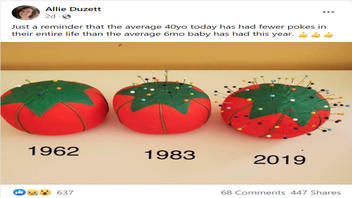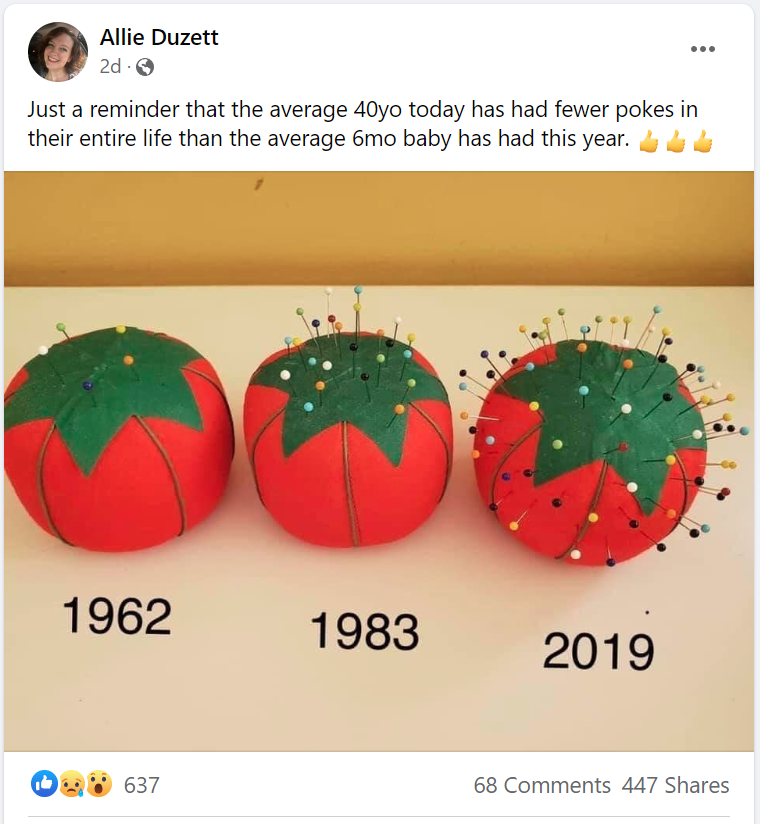STORY UPDATED: check for updates below.

Will a 6-month-old baby get more shots this year than a 40-year-old has already had in their lifetime? It depends on the person choosing their vaccinations. Using the Centers for Disease Control and Prevention's (CDC) Child and Adolescent Immunization Schedule that was available on August 19, 2022, Lead Stories counted 16 recommended childhood shots through the first six months of life. If you add COVID-19 and flu shots, the number of vaccinations at that age grows to 18. This is about twice what was recommended and available in the early 1980s, when fewer medicines were available for common diseases and viruses.
The number of additional shots a person will have over their life depends on their general health and any additional risk factors they may have. Using the CDC's Adult Immunization Schedule, which includes recommendations for people ages 19 and older, a person born in the early 1980s may receive additional vaccinations ranging anywhere from 10 to as high as 80 by the time they turn 40 if you include annual flu shots. COVID vaccinations are not a part of that number.
The claim appeared in a Facebook post published by "Professional Intuitive Healer" Allie Duzett's page on August 16, 2022. It opens:
Just a reminder that the average 40yo today has had fewer pokes in their entire life than the average 6mo baby has had this year. 👍👍👍
The illustration includes pincushions for the years 1962, 1983 and 2019. This is what the post looked like on Facebook at the time of writing:
(Source: Facebook screenshot taken on Fri Aug 19 15:45:25 2022 UTC)
The Facebook post itself includes no basis for the assertion.
Different vaccine eras
In an August 19, 2022, email to Lead Stories, Cincinnati Children's Hospital Medical Center explained how the post may or may not be true:
- We have combo shots now, which makes comparison of 'pokes' in the present day and 40 years ago a bit difficult. (According to the CDC, 'combination vaccines reduce the number of shots your child needs while protecting against the same number of serious diseases.') About Combination Vaccines for Children | CDC
- We are able to vaccinate against more infectious diseases now than 40 years ago. We have less incidence of disease because of that. For example, chicken pox is rare now, but 40 years ago most people got the disease.
- Because there are now more vaccines against infectious diseases, the possible number of injections has increased for children (by 2 years of age). See Table 1 on this link (but note that this is from 2002): Addressing Parents' Concerns: Do Multiple Vaccines Overwhelm or Weaken the Infant's Immune System? | Pediatrics | American Academy of Pediatrics (aap.org)
- More vaccines are also available to adults (such as the shingles vaccine, which was first licensed by the FDA in 2006 https://www.cdc.gov/vaccines/vpd/shingles/public/shingrix/ ) .... According to the CDC, 'immunizations are not just for children. Protection from some childhood vaccines can wear off over time. You may also be at risk for vaccine-preventable disease due to your age, job, lifestyle, travel, or health conditions.' https://www.cdc.gov/vaccines/adults/rec-vac/index.html
- Maybe more important is that the antigens given via vaccines has actually decreased over time. Antigens induce immune responses. Vaccines are better and more effective with smaller antigen volumes over time.
- According to the research article 'Addressing Parents' Concerns: Do Multiple Vaccines Overwhelm or Weaken the Infant's Immune System?' from Pediatrics Volume 109, Issue 1, Page 127 of January 2002:
- In 1960, there were 3,217 antigens in vaccines that protected against smallpox, diphtheria, tetanus, pertussis, and polio.
- By 2000, the number of antigens had decreased to between 123 and 126, which protected against diphtheria, tetanus, pertussis, polio, measles, mumps, rubella, Haemophilus Influenza Type B, varicella, pneumococcus and hepatitis B. ... See Table 2 of this link: Addressing Parents' Concerns: Do Multiple Vaccines Overwhelm or Weaken the Infant's Immune System? | Pediatrics | American Academy of Pediatrics (aap.org)
History of vaccines
The number of recommended vaccines has grown over the years as scientists have discovered new cures and as new viruses, like COVID-19, have spread. In the late 1940s, the schedule only included smallpox, diphtheria, tetanus and pertussis. In 1955, the polio vaccine was added. The smallpox vaccine was no longer recommended after 1972. The World Health Assembly declared smallpox eradicated in 1980. No cases of naturally occurring smallpox have happened since.
In the early 1980s, this is what the vaccine schedule looked like for today's 40-year-olds:
- Diphtheria*
- Tetanus*
- Pertussis*
- Polio (OPV)
- Measles**
- Mumps**
- Rubella**
* Given in combination as DTP
** Given in combination as MMR
This has been the vaccine schedule for children since 2011:
- Diphtheria*
- Tetanus*
- Pertussis*
- Measles**
- Mumps**
- Rubella**
- Polio (IPV)
- Hib
- Hepatitis B
- Varicella
- Hepatitis A
- Pneumococcal
- Influenza
- Rotavirus
* Given in combination as DTaP
** Given in combination as MMR
Updates:
-
2022-08-22T17:49:27Z 2022-08-22T17:49:27Z Corrects publish date for Addressing Parents' Concerns: Do Multiple Vaccines Overwhelm or Weaken the Infant's Immune System? | Pediatrics | American Academy of Pediatrics (aap.org) to 2002 from 1986.
















